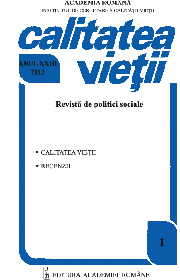Economia socială la sfârşit de secol XIX şi astăzi. Două încercări de construcție şi definire
Social economy at the end of XIXth century and today. Two test construction and definition
Author(s): Călin CotoiSubject(s): Social Sciences
Published by: Editura Academiei Române
Keywords: social economy; inscription; fin-de-siecle; Fordism; third way
Summary/Abstract: Social Economy is a rather new and ambiguous presence in the area of discourses and practices that target the so-called „Third Sector”. It can be seen on various backgrounds that lend it some specificity and historicity: the cooperative movement, the emergence of social experts and expertise, a third way ideology, a form to represent and create new socio-economic areas or an alternate way of moralizing and governing, at the margins of the market or the state bureaucracies. I propose here a reflection that connects the social economy of nowadays with its predecessor, the fin-de-siecle social economy. The problems that haunted the attempts to represent and regularize a „social economy” around 1990s are similar to the present day ones. Ch. Gide’s attempt at a third way synthesis – that had at its core social economy – might seem ideological, or even utopian, but it was aimed at overcoming ideologies and utopias, like socialism or oppression and social injustice, like those bred by capitalism. The failures of social economy were not so much ideological ones, as failures inside the processes and institutions used for inscribing, representing and controlling the ambiguous field social economy was to cover. Social economy did not gain enough consistency for surviving and overcoming its competitors in the social, economic and moral fields because it could not be represented in a stable and reproducible way. The inconsistencies of social economy in fin-de-siecle and after WWI and WWII have various causes. The two World Wars and the experience of planned economies that accompanied them were followed by the emergence of a „fordist” economic, social, and political system, in the postwar period. A trichotomic political imaginary: state, market and civil society was able to shape, authoritatively, the ways the social world was being understood and acted upon. Interference and in-between areas were hard to conceptualize in other ways than a so-called „intersection” of the three sectors. Social economy had no more spaces for development, or even for visibility. The type of social expertise that appeared during fordism had no need for a generalist and diffuse discourse, like Gide, Say or Bourgeois’s social economy. The renewed interest in social economy from the 1990s has to do with the changes going on in governmentality forms and in the worldwide political and economic structures, that usually go under the name of neoliberalism. The disappearance of the fordist model slowly eroded the trichotomic spatial socio-political metaphor that organizes the social world. Social Economy became visible and interesting, even if in a fragmentary way, once the „sectors” and their inter-relationships entered into a prolonged crisis. The welfare state is not or cannot be sustained anymore by a market economy that re-shapes itself globally, and the interests vested in the solid collaboration between state and civil society partially vanished. This does not necessarily mean that
Journal: Calitatea vieţii
- Issue Year: XXIV/2013
- Issue No: 2
- Page Range: 93-108
- Page Count: 16
- Language: Romanian

